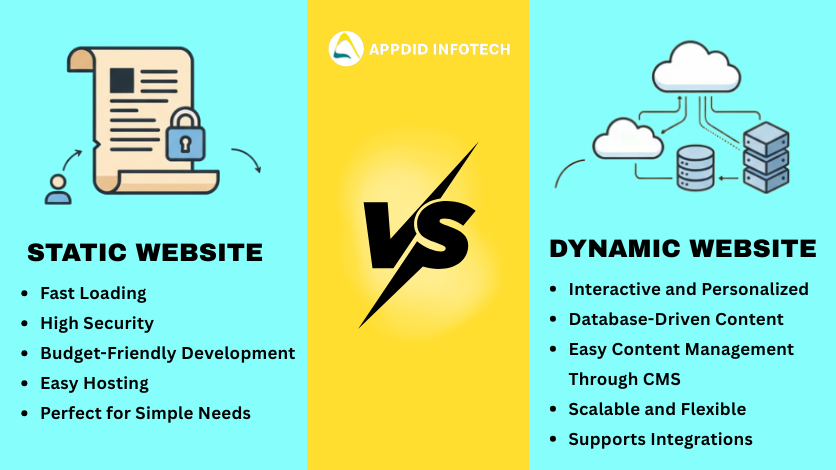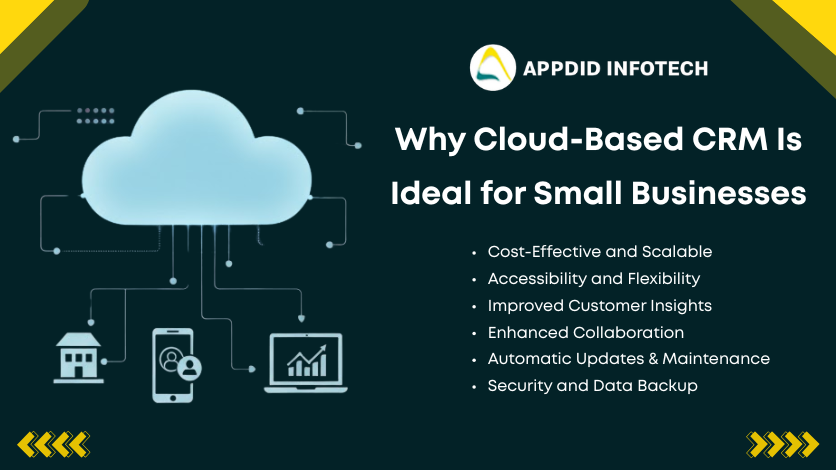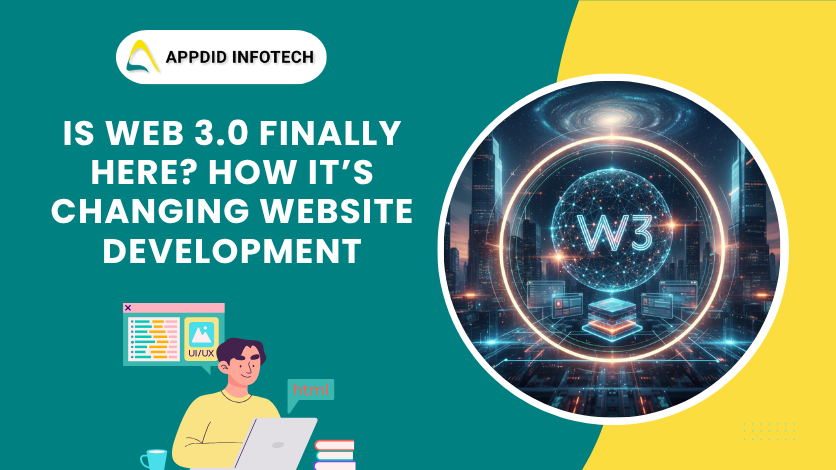Static vs. Dynamic Websites: Key Differences Explained
A business website is more than just a digital presence it is a powerful tool that shapes credibility, builds trust, and influences conversions. With countless businesses moving online, choosing the right type of website has become increasingly important. As explained by Appdid, understanding the difference between static and dynamic websites helps businesses make smarter decisions that align with their goals, budget, and long-term digital needs.
This blog explores both types of websites in detail, including their structure, advantages, ideal use cases, and expert recommendations to help you make an informed choice.
What Is a Static Website?
A static website is made up of fixed web pages coded using HTML, CSS, and sometimes JavaScript. The content of each page remains the same for all users unless manually updated by a developer.
Key Characteristics of Static Websites
Fast Loading
Static websites load extremely quickly because they deliver pre-built HTML files directly from the server without needing backend processing.
High Security
Since they do not interact with databases or server-side scripts, they offer a strong level of security.
Budget-Friendly Development
Static websites require less development effort and no back-end programming, making them a cost-effective option.
Easy Hosting
They work smoothly on any hosting platform and require minimal configuration.
Perfect for Simple Needs
They are ideal for websites that don’t need frequent changes or user interactions.
When Should You Choose a Static Website?
Static websites are an excellent choice for businesses or individuals needing a simple yet effective online presence.
Best Use Cases
-
Portfolio websites
-
Small business introduction sites
-
Landing pages
-
Events or invitations
-
Product catalogs without real-time updates
-
Brochure-style informational websites
Static websites provide clean designs, fast performance, and a seamless user experience especially beneficial for businesses that want simplicity and clarity.
What Is a Dynamic Website?
A dynamic website generates content in real time based on user actions, preferences, or data fetched from a database. These websites use backend programming languages like PHP, Python, JavaScript (Node.js), or .NET and connect to databases such as MySQL or MongoDB.
Key Characteristics of Dynamic Websites
Interactive and Personalized
Dynamic websites adapt content based on user input, making them ideal for platforms that require user engagement.
Database-Driven Content
Content is stored in a database, allowing easy and organized updates.
Easy Content Management Through CMS
Business owners can update content without coding by using CMS platforms like WordPress, Drupal, or custom admin panels.
Scalable and Flexible
As your business grows, dynamic websites can easily incorporate new features.
Supports Integrations
Dynamic websites connect smoothly with tools such as:
-
Payment gateways
-
CRM systems
-
Chatbots
-
Marketing automation tools
-
Inventory and order tracking systems
When Should You Choose a Dynamic Website?
Dynamic websites are suitable for businesses that need advanced features, automation, and regular content updates.
Best Use Cases
-
E-commerce websites
-
News and blog portals
-
Real estate listing websites
-
Booking and appointment platforms
-
Membership or login-based websites
-
LMS platforms (Learning Management Systems)
-
Large-scale business websites with frequent updates
Dynamic websites offer expansion capabilities and interactive experiences—making them ideal for growth-focused businesses.
Static vs. Dynamic Websites – A Detailed Comparison
Choosing the right website depends on your goals. Here is how both types compare:
🢂 Content Updates
Static Website:
Changes require manual editing of HTML files.
Dynamic Website:
Updating content is quick and easy through a user-friendly dashboard.
🢂 Performance & Speed
Static Website: Delivers lightning-fast load times.
Dynamic Website: Highly optimized but requires server processing and database interaction.
🢂Scalability
Static Website: Best for small-scale sites with limited features.
Dynamic Website: Extremely scalable to accommodate more pages, features, and integrations.
🢂 Functionality
Static Website: Ideal for simple information-sharing purposes.
Dynamic Website: Supports advanced features such as:
-
User login systems
-
Online payments
-
Search filters
-
Automated workflows
-
Dashboard access
🢂 User Experience
Static Website: Straightforward and minimalistic.
Dynamic Website: Interactive, personalized, and engaging.
Benefits of Static Websites
Static websites offer several advantages for businesses looking for speed and simplicity.
Instant Load Times
Because static files require no backend processing, users enjoy immediate access to content.
Strong Security
Fewer entry points mean stronger protection against cyber threats.
Low Maintenance Requirements
No constant updates or backend monitoring is needed.
Cost-Effective Solution
Perfect for new businesses or individuals with a limited budget.
Elegant and Clean Designs
Static websites can still have beautiful layouts, animations, and seamless visuals.
Benefits of Dynamic Websites
Dynamic websites come with advanced capabilities designed for modern business needs.
Easy Content Management
No coding is needed to update images, blogs, products, or text.
High Interactivity
User engagement features help keep visitors on your website longer.
Automation Features
Automated emails, notifications, and workflow systems increase productivity.
Designed for Growth
Dynamic websites scale as your business grows, making room for new functionalities.
Smooth Third-Party Integrations
From payment gateways to CRM tools, integrations help automate business operations.
Which Website Type Is Best for Your Business?
Making the right decision depends on your goals:
Choose a Static Website If You Want:
-
A fast and secure online presence
-
A budget-friendly solution
-
Minimal content updates
-
Simple, elegant pages
-
A lightweight website with clean navigation
Choose a Dynamic Website If You Want:
-
Frequent content updates
-
E-commerce capabilities
-
Automated features
-
User logins and personalization
-
Seamless scalability
Both static and dynamic websites serve important purposes. The right choice simply depends on how complex and interactive you want your digital presence to be.
Future Trends in Website Development
The world of web development is evolving rapidly. Here are some trends shaping the future:
Jamstack Websites
Combining static site speed with dynamic functionalities delivered via APIs.
Headless CMS
Allows businesses to manage content more flexibly across multiple platforms.
AI-Powered Personalization
Websites adapting content automatically based on user behavior.
Progressive Web Apps (PWAs)
Websites offering app-like experience, offline access, and faster loading.
Modern websites are becoming more intelligent, efficient, and user-focused.
Conclusion: Build Your Ideal Website with Appdid
Whether you need a fast-loading static website or a feature-rich dynamic platform, choosing the right web development partner makes all the difference. Appdid specializes in building modern, responsive, and scalable websites tailored to your business requirements. With a deep understanding of web technologies, Appdid ensures your online presence is strong, professional, and designed to support long-term growth.
Ready to build a powerful website for your business? Contact Appdid today and let our team help you create a digital presence that truly stands out.









